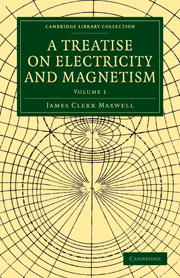Book contents
- Frontmatter
- PREFACE
- Contents
- ELECTRICITY AND MAGNETISM
- PRELIMINARY
- PART I ELECTROSTATICS
- PART II ELECTROKINEMATICS
- CHAPTER I THE ELECTRIC CURRENT
- CHAPTER II CONDUCTION AND RESISTANCE
- CHAPTER III ELECTROMOTIVE FORCE BETWEEN BODIES IN CONTACT
- CHAPTER IV ELECTROLYSIS
- CHAPTER V ELECTROLYTIC POLARIZATION
- CHAPTER VI MATHEMATICAL THEORY OF THE DISTRIBUTION OF ELECTRIC CURRENTS
- CHAPTER VII CONDUCTION IN THREE DIMENSIONS
- CHAPTER VIII RESISTANCE AND CONDUCTIVITY IN THREE DIMENSIONS
- CHAPTER IX CONDUCTION THROUGH HETEROGENEOUS MEDIA
- CHAPTER X CONDUCTION IN DIELECTRICS
- CHAPTER XI MEASUREMENT OF THE ELECTRIC RESISTANCE OF CONDUCTORS
- CHAPTER XII ELECTRIC RESISTANCE OF SUBSTANCES
- Plate section
CHAPTER III - ELECTROMOTIVE FORCE BETWEEN BODIES IN CONTACT
Published online by Cambridge University Press: 05 July 2011
- Frontmatter
- PREFACE
- Contents
- ELECTRICITY AND MAGNETISM
- PRELIMINARY
- PART I ELECTROSTATICS
- PART II ELECTROKINEMATICS
- CHAPTER I THE ELECTRIC CURRENT
- CHAPTER II CONDUCTION AND RESISTANCE
- CHAPTER III ELECTROMOTIVE FORCE BETWEEN BODIES IN CONTACT
- CHAPTER IV ELECTROLYSIS
- CHAPTER V ELECTROLYTIC POLARIZATION
- CHAPTER VI MATHEMATICAL THEORY OF THE DISTRIBUTION OF ELECTRIC CURRENTS
- CHAPTER VII CONDUCTION IN THREE DIMENSIONS
- CHAPTER VIII RESISTANCE AND CONDUCTIVITY IN THREE DIMENSIONS
- CHAPTER IX CONDUCTION THROUGH HETEROGENEOUS MEDIA
- CHAPTER X CONDUCTION IN DIELECTRICS
- CHAPTER XI MEASUREMENT OF THE ELECTRIC RESISTANCE OF CONDUCTORS
- CHAPTER XII ELECTRIC RESISTANCE OF SUBSTANCES
- Plate section
Summary
The Potentials of Different Substances in Contact
246.] If we define the potential of a hollow conducting vessel as the potential of the air inside the vessel, we may ascertain this potential by means of an electrometer as described in Part I, Art. 222.
If we now take two hollow vessels of different metals, say copper and zinc, and put them in metallic contact with each other, and then test the potential of the air inside each vessel, the potential of the air inside the zinc vessel will be positive as compared with that inside the copper vessel. The difference of potentials depends on the nature of the surface of the insides of the vessels, being greatest when the zinc is bright and when the copper is coated with oxide.
It appears from this that when two different metals are in contact there is in general an electromotive force acting from the one to the other, so as to make the potential of the one exceed that of the other by a certain quantity. This is Volta's theory of Contact Electricity.
If we take a certain metal, say copper, as the standard, then if the potential of iron in contact with copper at the zero potential is I, and that of zinc in contact with copper at zero is Z, then the potential of zinc in contact with iron at zero will be Z−I.
- Type
- Chapter
- Information
- A Treatise on Electricity and Magnetism , pp. 299 - 306Publisher: Cambridge University PressPrint publication year: 2010First published in: 1873



